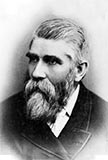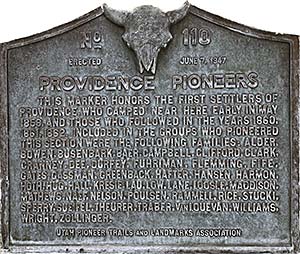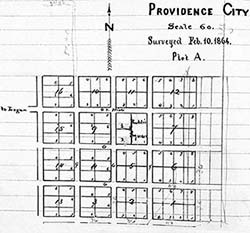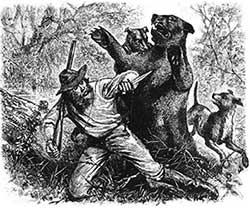Providence, 1859 ~ Index
The Early Settlement of Providence, Spring of 1859.

Except the company at Maughan's Fort, or Wellsville the next group to enter the valley and commence a new settlement was Hopkin Mathews, Sr., Joseph H. Campbbell, Frank Maddison, William Dees, Ira Rice, Samuel Campbell, William Fife, John Lane, Aaron DeWitt, Francis Hawkes and Henry W. Ballard and families. They arrived about April 20th, 1859 and made temporary headquarters at the Church Farm already established since 1855. John Theurer, Fred Theurer, Jaocb Zollinger and Ferdinand Zollinger were also early settlers of Spring Creek or Providence.
They looked over the valley and were impressed with the land and clear stream of water where Providence is now located. They forded the Blacksmith Fork River due east of the church farm and settled on the land near Spring Creek. At first the place was called Spring Creek but as the postal department would not accept the name because it contained two words, another name for the settlement had be be given. At the suggestion of President Brigham Young, the settlement was named Providence. Robert Williams was the first bishop.

Samuel and Joseph Campbell plowed the first furrow in Providence. In fact, Joseph Campbell came to the valley as early as the spring of 1857 and then decided to come back and settle in the valley. The settlers commenced at once to build their log houses and prepare the land for their crops. Mr. Henry W. Ballard and Aaron DeWitt took up land near the present location of the Ballard Springs on the state highway just west of Providence. Consequently these springs were named the Ballard Springs.
The first log houses were built on the block just west of the present Theurer Brothers store on Main Street by Hopkin Mathews, Sr. and a Mr. Thompson. The streets extended diagonally from the northeast to the southwest. William Budge, who became second bishop of Providence and one of the first superintendents of the county schools and a prominent citizen of the valley, also occupied a log house just north of the present location of the Theurer Brothers store.
As Spring Creek or Providence was well situated at the mouth of the canyon where there was good hunting and the trail led into other canyons, it was frequented by Indians. It was therefore necessary to build a fort for better protection for the settlers. As rocks were quite plentiful and cheaper than securing logs or poles, a strong rock wall several feet high was constructed into the form of a square just north of the present public school building. Here all the settlers were enclosed and pretty well prepared to resist any attack by the Indians. Loop holes along the wall were also provided. In times of danger, all the settlers, their cattle and horses and all their belongings were gathered into the fort.
On the present site of the tithing office building a log house was built where the first public school and church meetings were held. Charles Wright was the first schoolteacher and taught the school in this log cabin. A little later a larger log building was constructed southwest of the present rock meeting house in what was known as the old Hall lot. Here the public school and meetings were held and all the community activities centered for a number of years. Miss Emily Maddison, Annie Brown, James Bullock, John Barker and Walter Hodges were the early schoolteachers.

Later the town site was surveyed and laid off into blocks with eight acres to a block and one and one-third acres to a lot. The settlers drew lots for their lots and moved onto them. A few years later the present rock building on the public square was constructed for a meeting house and it stands today as a monument and proof of how well the early settlers of Providence built. When Brigham Young inspected the building he was much impressed with it and promised that it would give good service for many years. This it has done.
The settlers soon became aware they could not get sufficient water for irrigation from Spring Creek so they went south to the Blacksmith Fork River, a distance of five or six miles and with the aid of some of the settlers of Millville started the construction of an irrigation canal. The first survey was faulty and the canal was not a success so another survey was made and a new canal was dug that proved successful. Later, another canal from the Blacksmith Fork River was dug with cooperation from the settlers at Millville and this brought many more acres of land under irrigation in both settlements.
Providence, like the other settlements that followed, began to build new industries and manufacture some of the urgent and necessary commodities. William Smith built the first sawmill in Spring Creek Canyon. This was an upright saw and was operated by man power and was rather hard and slow work. However, it was the means of providing considerable rough lumber to help build the houses and corrals for the settlers. Mr. Edward Basset built a molasses kiln at the mouth of Dry Canyon to the north of the town. Mr. Charles W. Penrose now a member of the Presidency of the Mormon Church also helped to operate a molasses mill with his brother-in-law, Mr. Stratford, in the early days of the settlement. Mr. Hunsaker and James Brown had a small brick yard but it was not a success. The real brick-maker of Providence and for the valley for a number of years later, was Mr. Henry Gessell. In the later years many of the houses and public buildings in the valley were made from brick manufactured by Mr. Gessell and his company. Mr. James Bullock was the first cobbler and shoemaker and later became one of the village school teachers.
Milton D. Hammond who became one of the prominent and substantial citizens and community builders of the settlement and county as well and his two sons, Melvin and James T. Hammond, acquired a mill site at Millville and here they constructed one of the most modern and up-to-date grist mills in the valley. It serviced a good portion of the south end of the valley and made an excellent brand of flour. Mr. Hammond also served as Probate Judge of the county and as bishop of Providence for a number of years. The Providence Co-op was really the first mercantile institution in the settlement. However, Sam Hargraves conducted a small store in his home just east of the present home of James Hansen and Hyrum and Dell Rice; also sold a little merchandise in a small log building near the present amusement hall.
One of the first dramatic companies consisted of William Budge, son of Thomas Budge of Ogden; Joan Mathews, now Mrs. Joan Mathews Johnson of Idaho Falls; Charles Johnson and others. They performed in the old log school building know as the Old Hall and they played, "Bluebeard," "Rent Day," "The Bar Room," "Ben Bolt" and "Rough Diamond." At first they used a bedspread for a curtain on the stage. Later Mr. Alfred Lambourne and Reuben Kirkham, two early artists of Utah, painted some scenery for the company. Miss Joan Mathews had exceptional native ability as an actress and would have made a reputation with better opportunities for training.

The death of Henry Gates through a fight with a large grizzly bear to help save the life of another companion, was one of the first events to sadden the hearts of the early settlers. Ira Rice, one of the first settlers at Providence, had been quite a successful trapper and he had hides of bear, mountain lion, coyotes, wild cats, wolves and other animals stuffed with straw and hung around his log cabin. At certain times of the year grizzly bears frequented the river bottoms to catch frogs and gather roots and the tender shoots of different plants. Mr. Rice got on the trail of an exceptionally large grizzly where the big Ballard Spring empties into the Blacksmith Fork River. He set a trap and used Cottonwood logs for a toggle. When he visited the trap, it and all the toggle were gone and he gave the alarm and a number of citizens with Henry Gates included, made a hunt for the bear. They trailed him down the river to a point just north of the present Logan Sugar Factory in a thick clump of brush.
The bear jumped from the brush and grabbed Alpheus Harmon by the small of the back. Henry Gates immediately came to his rescue and was going to shoot the bear when it leaped from Harmon onto Gates and crushed him to the ground. In order to protect his body as much as possible Gates pushed his arm down the bear's throat and he nearly lost his arm. The bear chewed him in a terrible condition and even bit through the tough sole leather of Gates' boots into his foot. To help Gates, William Dees, who was in a large tree just above the fight, jumped down on the bear and shot it in the ear and killed it. Gates was placed in a wagon covered with boughs and brought to Providence. For several days he was nursed in the log house of Ira Rice, near the present amusement hall, but he died from blood poison. Harmon carried the effects of the bear's attack on him to his grave. The bear weighed nearly one thousand pounds. It was dressed and steaks were given to all who desired them. Juicy steaks from a fat bear were relished by many people in those days.
Note:
The following information has been received from John H. Baker of Cache Junction to supplement the account of the early history of Providence. It is a copy of a contract between John Barker school teacher, father of John H. Barker; and a number of citizens of Providence for Barker to teach school to their children and the amount Barker was to receive for his services.
Providence, November 20th, 1866
We the undersigned citizens of Providence do hereby agree to pay John Barker (Teacher) one bushel and half of wheat or its value, per quarter, for the schooling of each scholar we sign for. The Quarter is commence December 3rd, 1866.
William Budge, 2 students; James Fife, 2; Thomas Horsley, 1; John Looslie, 2; Hopkin Mathews, 3; Edwin Stratford, 2; James H. Brown, 1; Rudolph Hug, 1; Charles H. Rammell, 1; Jacob Naeff, 1; H.M. Harmon, 2; George W. Marler, 1; John Lane, 1; Christian Poulsen, 1; Samuel Hargraves, 2; Benjamin Tibbitts, 2; Milton D. Hammond, 3; Lelen Hunter, 1; Tilmon Clifford, 1; Leander Clifford, 1; H.D. Durfey, 2; Fredrick Lerjer, 1; John King, 3; Oscar N. Rice, 1; Asaph Rice, 1; Potter Bowen, 2; Crandall Dunn, 1; Jasper Thornton, 1; Founton Welch, 2; Ammon Harmon, 1; and Henry D. Busenbark, 2.
For the first Quarter of schooling in 1867 the following citizens signed the same contract with Baker. The Quarter commenced March 4th, 1867.
Oscar N. Rice, 2 students; Johathan Bowen, 1; James Fife, 2; Founton Welch, 2; Potter Bowen, 2; H.D. Durphey, 1; Francillo Durphey, 1; William N. Marler, 4; John Ulrich Haderil, 2; James H. Brown, 1; Hopkin Mathews, 3; Edwin Stratford, 1; H.M. Harmon, 2; Asaph Rice, 1; Crandall Dunn, 1; Jacob Naef, 1; Thomas W. Horsley, 1; Jacob Fuhriman, 1; Charles H. Rammell, 1; Milton D. Hammond, 3; William Budge, 2; and Henry D. Busenbark, 2.
For the next Quarter of schooling in 1867 the following citizens signed the same contract with Barker. The quarter commenced June 10th, 1867.
William Marler, 4 students; Founton Welch, 2; Marcellus Monroe, 1; Samuel Haegraved, 2; J. Campbell, 1; Edwin Stratford, 2; Hopkin Mathews, 5; Jacob Swifel, 1; J. Fuhriman, 1; James Fife, 2; Henry Busenbark, 2; Jacob Naef, 1; Charles H. Rammell, 1; John Ulrich Haderle, 2; Mr. Hartman, 1; B. Tibbitts, 1; H. Harmon, 2; William Budge, 2; Milton D. Hammond, 3; H. Brown, 1; A. Neever, 1; and W. Watts, 1.
Notes…
Also See: The Recovery of Reuben Van Ornum, and the battle up Providence Canyon, in late November of 1862 by the California Volenters under the comand of Major Edward McGarry.